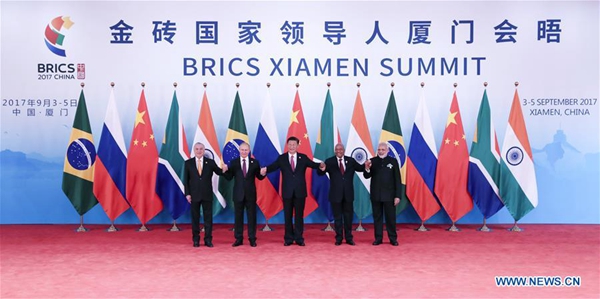BRICS summit: Overcoming sluggish growth and threats to peace
- By Tim Collard
 0 Comment(s)
0 Comment(s) Print
Print E-mail China.org.cn, September 18, 2017
E-mail China.org.cn, September 18, 2017
 |
|
Leaders of BRICS countries take a group photo. [Xinhua] |
China's recent diplomatic efforts have involved a number of separate but frequently interlocking annual high-level meetings.
This is, of course, most constructive, given the increasing networking of the world’s economies, but it's always possible that work on one area can be eclipsed by more attractive or more urgent work on another. Inevitably, the focus of world attention will shift from time to time.
These days, it could be argued that much of the substance of the BRICS economic agenda has been subsumed, for China at least, given the wider concerns of the Belt and Road initiative.
All BRICS partner countries represent important nodes in the global network that China is attempting to establish with her flagship program. Also, current weaknesses in the global economy have led to a reining-in of expectations.
President Xi Jinping recognized this in his opening speech at the BRICS summit in Xiamen, saying, "The global economy remains in a period of adjustment, with weakness in growth and an apparent absence of new economic drivers. This sluggish growth has given rise to an inward-looking mentality and protectionist tendencies."
China, as we know, maintains an absolute commitment to openness and free trade.
Despite these problems, the four State Presidents of China, Russia, Brazil and South Africa, plus Indian Prime Minister Narendra Modi, managed to put together a comprehensive and constructive agenda on September 3-5.
Unsurprisingly, in the current international climate, the focus shifted somewhat from traditional economic to security issues; on those issues, larger states like those comprising BRICS necessarily assume a weightier role.
Nonetheless, China led the way in broadening the base for talks at the BRICS summit by inviting leaders of smaller countries to participate in a parallel forum, the Dialogue of Emerging Markets and Developing Countries, where the leaders of Egypt, Guinea, Mexico, Tajikistan and Thailand joined the BRICS leaders in discussing the global development and “South-South” cooperation agendas.
This is an advance on the previous BRICS outreach programs, which formerly only featured neighbors of the host country.
However, prior to the summit, there were worries that recent dissensions between China and India might present an obstacle to discussions, following the long border stand-off at Doklam. Some good preparatory work was done between the two leaders at the G20 summit in Hamburg in July, and there has been a noticeable relaxation of tension since then, enabling the Indian and Chinese leaders to meet in Xiamen on better terms.
There are other running issues between the two Asian giants, in particular the fact that one of the strongest cooperative partnerships in the Belt and Road program in Asia is that between China and Pakistan, India’s long-standing regional rival.
This cooperation requires Chinese security support to safeguard the infrastructural projects against terrorism, causing India some disquiet at times.
Still, so long as Chinese and Indian leaders are talking (they had a bilateral session on the margins of the conference), progress towards a relaxation of tensions is being made.
And the summit agreed, for the first time, to mention in its Joint Declaration certain Pakistan-based Islamist organizations by name as terrorist conspirators, further helping cordiality between India and China, who have a common interest in fighting terrorism in South Asia.
President Xi described the guiding principle of the BRICS process as "dialogue without confrontation, partnership without alliance." This represents the shape of recent Chinese diplomatic efforts aimed at establishing a multi-layered network (bilateral and multilateral) throughout the world, underpinning long-term global stability with a web of mutually beneficial economic interests giving each country a stake in cooperation.
Obviously, China is not in a position to mastermind all these networks, except for the Belt and Road Initiative, a truly Chinese project; they simply arise as the result of various initiatives from various countries, and China makes what use of them it can, all the time aiming for maximum integration between the different networks.
However, this approach is a genuine new departure for China, which previously had a reputation for standing rather aloof from multilateral diplomacy, no doubt in pursuit of the long-standing Chinese policy of avoiding entangling alliances.
Now, however, it recognizes it is perfectly possible to enter into mutually beneficial international partnerships without in any way compromising one’s freedom of action. This is a major step in promoting world peace.
Tim Collard is a columnist with China.org.cn. For more information please visit:
http://www.ccgp-fushun.com/opinion/timcollard.htm
Opinion articles reflect the views of their authors, not necessarily those of China.org.cn.





